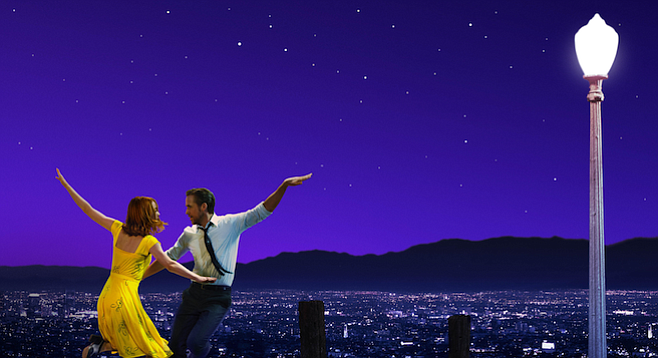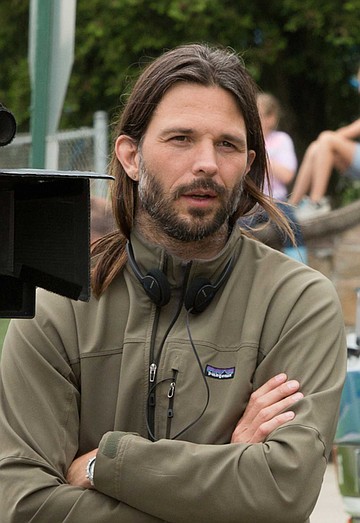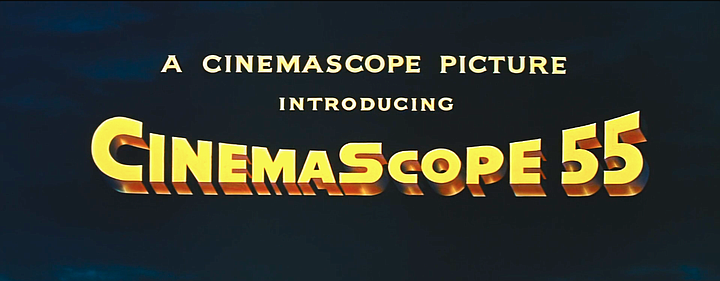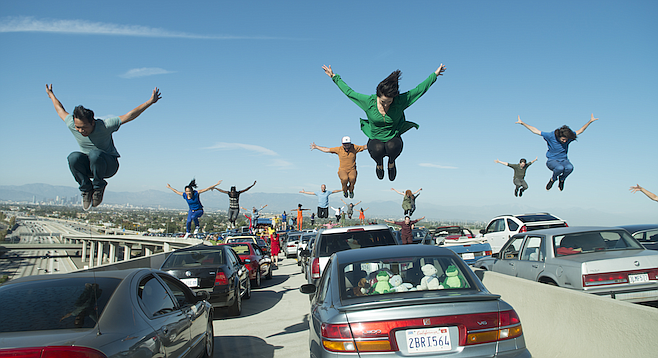 Facebook
Facebook
 X
X
 Instagram
Instagram
 TikTok
TikTok
 Youtube
Youtube

When was the last time you saw an expressionistic use of color in a trailer, let alone a feature? There was more color in the preview for La La Land than a box of 120 Crayola Crayons. It was the only time I put in a request for an interview based solely on a coming attraction.
Cinematographer Linus (pronounced: LEE-nus) Sandgren spent the better part of the last decade filming shorts and television shows and one feature (Storm) in his native Stockholm. He broke into American films in 2010 when he was hired to shoot Gus Van Sant’s Promised Land. This was followed by a pair of gems for David O. Russell (American Hustle and Joy) and a colorful comedy for Lasse Hallström, The Hundred-Foot Journey.
It’s not even Christmas, and his work on La La Land has already earned Sandgren several awards nominations. Sandgren’s very modest when the subject of awards comes up, but we’re thinking it’s a shoe-in.
Scott Marks: Here’s one question I thought I’d never ask, but in this case it makes perfect sense. What’s your favorite color?
Linus Sandgren (Laughing): Well…what shall I say? I like color in general, but I think I love cyan. Blue and purple.
SM: The “twilight time” sequences in La La Land gave you away. Do you recall the first movie you watched where you took note of the cinematographer’s name?

LS: I think it’s Vilmos Zsigmond, actually. I grew up watching a lot of films and I always admired the cinematography in films, but I think the first one I was inspired by was Vilmos Zsigmond.
SM: Why cinematography as opposed to directing or editing?
LS: I think it is the storytelling. You tell a story with the characters and the acting but also with the camera. I love films where the camera is the storyteller and not only the observer, when you let the camera tell the story as well with the lighting and the movement and choice of lenses. The proper way to work as a cinematographer is to be a storyteller.
SM: I’ve always admired Hollywood’s ability to turn the ordinary into something fantastic. The 5-½ minute unbroken take where Ryan Gosling and Emma Stone are looking for her car, and the camera pans gently left to reveal the city at twilight time…I gasped. It’s stunning. At the risk of finding out there’s no Santa Claus, was that indeed one unbroken take or was it digitally enhanced?
LS (Laughing): That’s a real take. We rehearsed it in advance shooting on a flat surface in different ways. On the day of the shoot, we rehearsed for 12 hours – 7 in the morning to 7 at night – and then we shot it for five takes between 7 pm and 7:45 pm to catch the magic sky. We came back the day after and shot it again from 7 pm to 7:45 pm in the evening. It was really important for us to capture everything for real. As much as possible we wanted to capture it this way to add authenticity to what’s going on; the dance and the performance are really happening. We believe that you feel it more being there.
Billed as a movie lover’s dream for a reason: the eye hasn’t seen this much color on screen since Vincente Minnelli passed. The songs and musical numbers are lively, the cast attractive, all attempts to transform city streets into expressionistically lit studio backlots successful, and the ending decidedly downbeat. And there’s this five-and-a-half-minute long take that starts in search of a parked car and ends with a slow and deliberate pan over to the Hollywood Hills at twilight time that found me struggling to pick my jaw up from off the floor. Ditto a lovely romantic walking tour of the Warner Bros. lot. But, and it’s a big but, any number of the movie musicals that director Damien Chazelle references (The Umbrellas of Cherbourg, The Band Wagon, It’s Always Fair Weather, etc.) have more depth of characterization than either Ryan Gosling and Emma Stone’s comparative stick figures are assigned. But enough grouching. This is one crowd-pleaser worth getting behind.
A lot of people think it may be fake, that’s it’s so magic that it can’t possibly be true. That’s what’s so beautiful about Los Angeles. Those skies are very common. You have to time it perfectly…to the minute. I believe the take we have is take 8, between 7:25 pm and 7:30 pm on the Friday. Luckily we have a director who is a visual storyteller. He really appreciates the importance of the camera to tell the story. Some directors don’t. Some directors rely on the acting. Damien [Chazelle] relies on telling it both with the camera and the performers.
SM: You are the only cinematographer who has twice worked with David O. Russell. To what do you owe your longevity?
LS (Laughing): I love working with David. On American Hustle it was a learning curve to work with him. His way of working involves a lot of improvising. I can see that can be frustrating for a cinematographer sometimes. For me, every challenge I get is interesting. You look for challenges as well. You don’t get too comfortable doing one thing. If you’re used to doing things in a rational way, a conventional way...then you meet someone who has an unconventional method of working, and to me that’s interesting.
With David, I learned how to work with him on American Hustle. On Joy, I could fully embrace the work. He is a very generous director. What he’s great at is working in the moment. Like improvised jazz. Instead of having rehearsed everything like a normal band, when you improvise it’s the feeling between us that makes it. He relies a lot on how the acting goes at the moment. He has a special method.

SM: Why the CinemaScope 55 logo at the head of the film? Did you shoot in the 2.55:1 aspect ratio?
LS: Yes. Damien wanted to pay an homage to the craftsmanship of old Hollywood filmmaking. He wanted to raise the ’Scope format, like you shoot anamorphic in 2.40:1. In our discussion we talked about old films and on one hand, all of the musicals made prior to 1953 were shot in 1.33:1. Films like A Star Is Born and Rebel Without a Cause were in CinemaScope 2.55:1.
With the 2.40:1 ratio on 35mm film, you’re not utilizing the entire negative. If you use the whole negative in Super35, it would be 2.66:1, so you could use 2.55:1 on the 35mm camera today. We asked Panavision to modify the camera so that we had ground glass to 2.55:1. It was really more to make it wider and give an homage to ’50’s CinemaScope. We wanted to add a certain timelessness with that.
SM: I read an interview where you asked Panavision to rebuild their anamorphic lens to accommodate a 9-inch focal length instead of the customary 3-inch range. Why couldn’t you work around the imposed limit and did it ever occur to you to simply use an old CinemaScope lens?
LS: First of all, that’s a misunderstanding in a magazine somewhere. It’s actually 19 inches. But’s it’s still a lot closer than the normal, which is like 3 feet. It helps. We wanted to work on a wide-angle lens, which was 40mm generally, our standard lens in the film. We wanted to use Panavision lenses because they have also have a classic Hollywood look to them with the blue streaks that comes when you flare them with the light. They have that special characteristic that to me is classic Hollywood. We wanted to work with them.
At Panavision they have these incredible great lab technicians. Dan Sasaki is the head of the lens department. He can basically accommodate any input from a cinematographer. We wanted a lens that had better close focus because we wanted to be more mobile sometimes and be able to, in long takes, we wanted pull out from a close-up of Ryan Gosling’s hands on the piano to a wide shot. We felt a little limitation in the normal distance in the close focus. So he basically put together a new lens for us.

SM: Did Damien put together a recommended viewing list of films that he wanted to reference in the movie? If so, what films made the list and how many of them had you see prior to shooting?
LS: I hadn’t seen Umbrellas of Cherbourg. We watched M-G-M musicals like The Band Wagon and Singin’ in the Rain and others. He had a whole library of films that we watched for inspiration. We couldn’t really take much from them other than inspiration. It helped us give the modern world a much more timeless feel. He had screenings for the crew one night a week so we could watch them together.
SM: The film is already racking up a ton of nominations from critic’s groups. In fact you’ve already won the best Cinematography honors at this year’s Hollywood Film Awards. Of the movies you’ve seen this year, which one do you think is going to be your biggest competition for Oscar gold?
LS (Nervous laugh): I dunno. I don’t even want to speculate about being nominated. I really just appreciate the acclaim that the film is getting. I’m honored to be part of that. There are many great films right now that are up there, but I haven’t seen them myself. (Laughing.)
SM: I can’t tell you how gratifying it was to see a film that actually uses color. So many films today get locked into this achromatic format where everything is slate gray or steely blue. I had to don sunglasses in order to get through the trailer for La La Land.
LS: To me color is very important, even in a film like Joy, which is a kind of monochromatic film. If you look at it, it had a lot of color even though the colors in the set are basically monochromatic. There’s flesh tones and full color, but it’s different from being saturated. La La Land has a lot of color, but the saturation level is in the middle – no over saturation or desaturation. It has a lot of color because the film stock captures all the colors, and we work with colored lights and lots of colors in the sets.
I appreciate color. Even a white wall to me should have color. In classic photography there’s always a bluer hue in the shadows. Even on a white wall there’s a blue tint in the shadows or a warmth in the sun perhaps. That’s more complex and interesting to me that you can see color. In any film I like to work with colors because I think they model the world better when it’s full color. I totally see the difference between film and digital in that sense. That’s why I still prefer to shoot on film. It has more latitude.


When was the last time you saw an expressionistic use of color in a trailer, let alone a feature? There was more color in the preview for La La Land than a box of 120 Crayola Crayons. It was the only time I put in a request for an interview based solely on a coming attraction.
Cinematographer Linus (pronounced: LEE-nus) Sandgren spent the better part of the last decade filming shorts and television shows and one feature (Storm) in his native Stockholm. He broke into American films in 2010 when he was hired to shoot Gus Van Sant’s Promised Land. This was followed by a pair of gems for David O. Russell (American Hustle and Joy) and a colorful comedy for Lasse Hallström, The Hundred-Foot Journey.
It’s not even Christmas, and his work on La La Land has already earned Sandgren several awards nominations. Sandgren’s very modest when the subject of awards comes up, but we’re thinking it’s a shoe-in.
Scott Marks: Here’s one question I thought I’d never ask, but in this case it makes perfect sense. What’s your favorite color?
Linus Sandgren (Laughing): Well…what shall I say? I like color in general, but I think I love cyan. Blue and purple.
SM: The “twilight time” sequences in La La Land gave you away. Do you recall the first movie you watched where you took note of the cinematographer’s name?

LS: I think it’s Vilmos Zsigmond, actually. I grew up watching a lot of films and I always admired the cinematography in films, but I think the first one I was inspired by was Vilmos Zsigmond.
SM: Why cinematography as opposed to directing or editing?
LS: I think it is the storytelling. You tell a story with the characters and the acting but also with the camera. I love films where the camera is the storyteller and not only the observer, when you let the camera tell the story as well with the lighting and the movement and choice of lenses. The proper way to work as a cinematographer is to be a storyteller.
SM: I’ve always admired Hollywood’s ability to turn the ordinary into something fantastic. The 5-½ minute unbroken take where Ryan Gosling and Emma Stone are looking for her car, and the camera pans gently left to reveal the city at twilight time…I gasped. It’s stunning. At the risk of finding out there’s no Santa Claus, was that indeed one unbroken take or was it digitally enhanced?
LS (Laughing): That’s a real take. We rehearsed it in advance shooting on a flat surface in different ways. On the day of the shoot, we rehearsed for 12 hours – 7 in the morning to 7 at night – and then we shot it for five takes between 7 pm and 7:45 pm to catch the magic sky. We came back the day after and shot it again from 7 pm to 7:45 pm in the evening. It was really important for us to capture everything for real. As much as possible we wanted to capture it this way to add authenticity to what’s going on; the dance and the performance are really happening. We believe that you feel it more being there.
Billed as a movie lover’s dream for a reason: the eye hasn’t seen this much color on screen since Vincente Minnelli passed. The songs and musical numbers are lively, the cast attractive, all attempts to transform city streets into expressionistically lit studio backlots successful, and the ending decidedly downbeat. And there’s this five-and-a-half-minute long take that starts in search of a parked car and ends with a slow and deliberate pan over to the Hollywood Hills at twilight time that found me struggling to pick my jaw up from off the floor. Ditto a lovely romantic walking tour of the Warner Bros. lot. But, and it’s a big but, any number of the movie musicals that director Damien Chazelle references (The Umbrellas of Cherbourg, The Band Wagon, It’s Always Fair Weather, etc.) have more depth of characterization than either Ryan Gosling and Emma Stone’s comparative stick figures are assigned. But enough grouching. This is one crowd-pleaser worth getting behind.
A lot of people think it may be fake, that’s it’s so magic that it can’t possibly be true. That’s what’s so beautiful about Los Angeles. Those skies are very common. You have to time it perfectly…to the minute. I believe the take we have is take 8, between 7:25 pm and 7:30 pm on the Friday. Luckily we have a director who is a visual storyteller. He really appreciates the importance of the camera to tell the story. Some directors don’t. Some directors rely on the acting. Damien [Chazelle] relies on telling it both with the camera and the performers.
SM: You are the only cinematographer who has twice worked with David O. Russell. To what do you owe your longevity?
LS (Laughing): I love working with David. On American Hustle it was a learning curve to work with him. His way of working involves a lot of improvising. I can see that can be frustrating for a cinematographer sometimes. For me, every challenge I get is interesting. You look for challenges as well. You don’t get too comfortable doing one thing. If you’re used to doing things in a rational way, a conventional way...then you meet someone who has an unconventional method of working, and to me that’s interesting.
With David, I learned how to work with him on American Hustle. On Joy, I could fully embrace the work. He is a very generous director. What he’s great at is working in the moment. Like improvised jazz. Instead of having rehearsed everything like a normal band, when you improvise it’s the feeling between us that makes it. He relies a lot on how the acting goes at the moment. He has a special method.

SM: Why the CinemaScope 55 logo at the head of the film? Did you shoot in the 2.55:1 aspect ratio?
LS: Yes. Damien wanted to pay an homage to the craftsmanship of old Hollywood filmmaking. He wanted to raise the ’Scope format, like you shoot anamorphic in 2.40:1. In our discussion we talked about old films and on one hand, all of the musicals made prior to 1953 were shot in 1.33:1. Films like A Star Is Born and Rebel Without a Cause were in CinemaScope 2.55:1.
With the 2.40:1 ratio on 35mm film, you’re not utilizing the entire negative. If you use the whole negative in Super35, it would be 2.66:1, so you could use 2.55:1 on the 35mm camera today. We asked Panavision to modify the camera so that we had ground glass to 2.55:1. It was really more to make it wider and give an homage to ’50’s CinemaScope. We wanted to add a certain timelessness with that.
SM: I read an interview where you asked Panavision to rebuild their anamorphic lens to accommodate a 9-inch focal length instead of the customary 3-inch range. Why couldn’t you work around the imposed limit and did it ever occur to you to simply use an old CinemaScope lens?
LS: First of all, that’s a misunderstanding in a magazine somewhere. It’s actually 19 inches. But’s it’s still a lot closer than the normal, which is like 3 feet. It helps. We wanted to work on a wide-angle lens, which was 40mm generally, our standard lens in the film. We wanted to use Panavision lenses because they have also have a classic Hollywood look to them with the blue streaks that comes when you flare them with the light. They have that special characteristic that to me is classic Hollywood. We wanted to work with them.
At Panavision they have these incredible great lab technicians. Dan Sasaki is the head of the lens department. He can basically accommodate any input from a cinematographer. We wanted a lens that had better close focus because we wanted to be more mobile sometimes and be able to, in long takes, we wanted pull out from a close-up of Ryan Gosling’s hands on the piano to a wide shot. We felt a little limitation in the normal distance in the close focus. So he basically put together a new lens for us.

SM: Did Damien put together a recommended viewing list of films that he wanted to reference in the movie? If so, what films made the list and how many of them had you see prior to shooting?
LS: I hadn’t seen Umbrellas of Cherbourg. We watched M-G-M musicals like The Band Wagon and Singin’ in the Rain and others. He had a whole library of films that we watched for inspiration. We couldn’t really take much from them other than inspiration. It helped us give the modern world a much more timeless feel. He had screenings for the crew one night a week so we could watch them together.
SM: The film is already racking up a ton of nominations from critic’s groups. In fact you’ve already won the best Cinematography honors at this year’s Hollywood Film Awards. Of the movies you’ve seen this year, which one do you think is going to be your biggest competition for Oscar gold?
LS (Nervous laugh): I dunno. I don’t even want to speculate about being nominated. I really just appreciate the acclaim that the film is getting. I’m honored to be part of that. There are many great films right now that are up there, but I haven’t seen them myself. (Laughing.)
SM: I can’t tell you how gratifying it was to see a film that actually uses color. So many films today get locked into this achromatic format where everything is slate gray or steely blue. I had to don sunglasses in order to get through the trailer for La La Land.
LS: To me color is very important, even in a film like Joy, which is a kind of monochromatic film. If you look at it, it had a lot of color even though the colors in the set are basically monochromatic. There’s flesh tones and full color, but it’s different from being saturated. La La Land has a lot of color, but the saturation level is in the middle – no over saturation or desaturation. It has a lot of color because the film stock captures all the colors, and we work with colored lights and lots of colors in the sets.
I appreciate color. Even a white wall to me should have color. In classic photography there’s always a bluer hue in the shadows. Even on a white wall there’s a blue tint in the shadows or a warmth in the sun perhaps. That’s more complex and interesting to me that you can see color. In any film I like to work with colors because I think they model the world better when it’s full color. I totally see the difference between film and digital in that sense. That’s why I still prefer to shoot on film. It has more latitude.
Comments